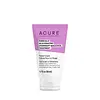What's inside
What's inside
 Key Ingredients
Key Ingredients

 Benefits
Benefits

 Concerns
Concerns

 Ingredients Side-by-side
Ingredients Side-by-side

Butyrospermum Parkii Butter
Skin ConditioningDimethicone
EmollientGarcinia Indica Seed Butter
Skin ConditioningMacadamia Integrifolia Seed Oil
Skin ConditioningGlycerin
HumectantGlyceryl Stearate
EmollientPEG-100 Stearate
Butylene Glycol
HumectantGossypium Herbaceum Seed Oil
Skin ConditioningSaccharide Isomerate
HumectantHoney
HumectantPanthenol
Skin ConditioningOphiopogon Japonicus Root Extract
Skin ConditioningCrocus Sativus Flower Extract
MaskingPadina Pavonica Thallus Extract
Skin ConditioningHydroxyethyl Acrylate/Sodium Acryloyldimethyl Taurate Copolymer
Emulsion StabilisingHydroxyethylcellulose
Emulsion StabilisingSimmondsia Chinensis Seed Oil
EmollientPropanediol
SolventSodium Polyacrylate
AbsorbentGlyceryl Caprylate
EmollientDisodium EDTA
Citric Acid
BufferingPolysorbate 60
EmulsifyingSorbitan Isostearate
EmulsifyingGlycine Soja Oil
EmollientEthylhexylglycerin
Skin ConditioningSodium Citrate
BufferingSodium Hydroxide
BufferingParfum
MaskingPhenoxyethanol
PreservativeSodium Benzoate
MaskingPotassium Sorbate
PreservativeTocopherol
AntioxidantGeraniol
PerfumingCitronellol
PerfumingButyrospermum Parkii Butter, Dimethicone, Garcinia Indica Seed Butter, Macadamia Integrifolia Seed Oil, Glycerin, Glyceryl Stearate, PEG-100 Stearate, Butylene Glycol, Gossypium Herbaceum Seed Oil, Saccharide Isomerate, Honey, Panthenol, Ophiopogon Japonicus Root Extract, Crocus Sativus Flower Extract, Padina Pavonica Thallus Extract, Hydroxyethyl Acrylate/Sodium Acryloyldimethyl Taurate Copolymer, Hydroxyethylcellulose, Simmondsia Chinensis Seed Oil, Propanediol, Sodium Polyacrylate, Glyceryl Caprylate, Disodium EDTA, Citric Acid, Polysorbate 60, Sorbitan Isostearate, Glycine Soja Oil, Ethylhexylglycerin, Sodium Citrate, Sodium Hydroxide, Parfum, Phenoxyethanol, Sodium Benzoate, Potassium Sorbate, Tocopherol, Geraniol, Citronellol
Water
Skin ConditioningCetearyl Alcohol
EmollientCarthamus Tinctorius Seed Oil
MaskingGlyceryl Stearate Citrate
EmollientCocoglycerides
EmollientAloe Barbadensis Leaf Juice
Skin ConditioningBakuchiol
AntimicrobialHelianthus Annuus Seed Oil
EmollientGlyceryl Laurate
EmollientTheobroma Cacao Seed Butter
EmollientSqualane
EmollientTocopherol
AntioxidantTocopheryl Acetate
AntioxidantOenothera Biennis Oil
EmollientArgania Spinosa Kernel Oil
EmollientChamomilla Recutita Flower Extract
MaskingCalendula Officinalis Flower Extract
MaskingGlycerin
HumectantSodium Anisate
AntimicrobialXanthan Gum
EmulsifyingSodium Levulinate
Skin ConditioningGlyceryl Caprylate
EmollientSodium Phytate
Potassium Sorbate
PreservativeCitric Acid
BufferingWater, Cetearyl Alcohol, Carthamus Tinctorius Seed Oil, Glyceryl Stearate Citrate, Cocoglycerides, Aloe Barbadensis Leaf Juice, Bakuchiol, Helianthus Annuus Seed Oil, Glyceryl Laurate, Theobroma Cacao Seed Butter, Squalane, Tocopherol, Tocopheryl Acetate, Oenothera Biennis Oil, Argania Spinosa Kernel Oil, Chamomilla Recutita Flower Extract, Calendula Officinalis Flower Extract, Glycerin, Sodium Anisate, Xanthan Gum, Sodium Levulinate, Glyceryl Caprylate, Sodium Phytate, Potassium Sorbate, Citric Acid
 Reviews
Reviews

Ingredients Explained
These ingredients are found in both products.
Ingredients higher up in an ingredient list are typically present in a larger amount.
Citric Acid is an alpha hydroxy acid (AHA) naturally found in citrus fruits like oranges, lemons, and limes.
Like other AHAs, citric acid can exfoliate skin by breaking down the bonds that hold dead skin cells together. This helps reveal smoother and brighter skin underneath.
However, this exfoliating effect only happens at high concentrations (20%) which can be hard to find in cosmetic products.
Due to this, citric acid is usually included in small amounts as a pH adjuster. This helps keep products slightly more acidic and compatible with skin's natural pH.
In skincare formulas, citric acid can:
While it can provide some skin benefits, research shows lactic acid and glycolic acid are generally more effective and less irritating exfoliants.
Most citric acid used in skincare today is made by fermenting sugars (usually from molasses). This synthetic version is identical to the natural citrus form but easier to stabilize and use in formulations.
Read more about some other popular AHA's here:
Learn more about Citric AcidGlycerin is already naturally found in your skin. It helps moisturize and protect your skin.
A study from 2016 found glycerin to be more effective as a humectant than AHAs and hyaluronic acid.
As a humectant, it helps the skin stay hydrated by pulling moisture to your skin. The low molecular weight of glycerin allows it to pull moisture into the deeper layers of your skin.
Hydrated skin improves your skin barrier; Your skin barrier helps protect against irritants and bacteria.
Glycerin has also been found to have antimicrobial and antiviral properties. Due to these properties, glycerin is often used in wound and burn treatments.
In cosmetics, glycerin is usually derived from plants such as soybean or palm. However, it can also be sourced from animals, such as tallow or animal fat.
This ingredient is organic, colorless, odorless, and non-toxic.
Glycerin is the name for this ingredient in American English. British English uses Glycerol/Glycerine.
Learn more about GlycerinGlyceryl Caprylate comes from glycerin and caprylic acid, a fatty acid from coconut. It has emollient and emulsifier properties.
As an emollient, it helps hydrate your skin. Emollients work by creating a barrier on your skin to trap moisture in, helping to keep your skin soft and smooth.
On the other hand, emulsifiers prevent ingredients (such as oil and water) from separating.
Learn more about Glyceryl CaprylatePotassium Sorbate is a preservative used to prevent yeast and mold in products. It is commonly found in both cosmetic and food products.
This ingredient comes from potassium salt derived from sorbic acid. Sorbic acid is a natural antibiotic and effective against fungus.
Both potassium sorbate and sorbic acid can be found in baked goods, cheeses, dried meats, dried fruit, ice cream, pickles, wine, yogurt, and more.
You'll often find this ingredient used with other preservatives.
Learn more about Potassium SorbateTocopherol (also known as Vitamin E) is a common antioxidant used to help protect the skin from free-radicals and strengthen the skin barrier. It's also fat soluble - this means our skin is great at absorbing it.
Vitamin E also helps keep your natural skin lipids healthy. Your lipid skin barrier naturally consists of lipids, ceramides, and fatty acids. Vitamin E offers extra protection for your skin’s lipid barrier, keeping your skin healthy and nourished.
Another benefit is a bit of UV protection. Vitamin E helps reduce the damage caused by UVB rays. (It should not replace your sunscreen). Combining it with Vitamin C can decrease sunburned cells and hyperpigmentation after UV exposure.
You might have noticed Vitamin E + C often paired together. This is because it is great at stabilizing Vitamin C. Using the two together helps increase the effectiveness of both ingredients.
There are often claims that Vitamin E can reduce/prevent scarring, but these claims haven't been confirmed by scientific research.
Learn more about Tocopherol